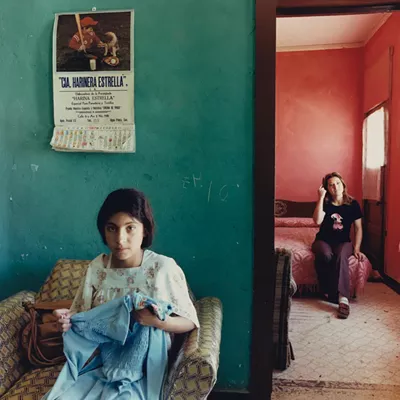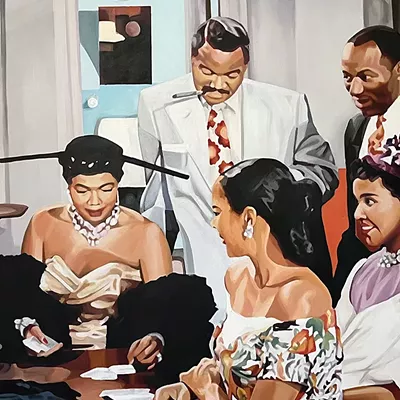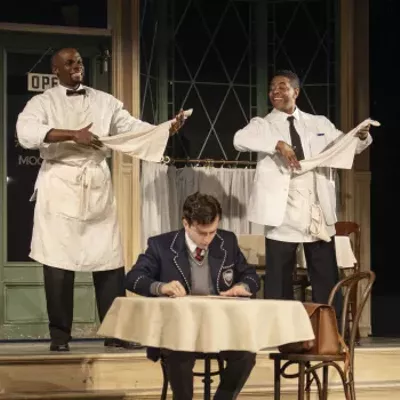Vincent Van Gogh might have used oils and canvas for his midnight-blue masterpiece, but Kratz used earthy materials for her "Light of Blue 1." Her translucent resin on board is colored a stellar blue, and little bits of the plant radiate through this celestial plane like so many twinkling stars.
To make her distinctive artworks--a cross between sculpture and painting--Kratz embeds lowly weeds, snake bones and yucca pods into layers of lustrous resin. The pieces are unabashedly about landscape; the irony, as she herself notes, is that they're more heavenly than earthy.
"Much of what I observe in nature ... appears stellar," she explains in an artist's statement, "and a great deal of what I view in the sky seems cellular."
The constellation of six works in the "Light of Blue" series, on view in a three-person show at Etherton Gallery, trace out a painterly sky in rhapsodic shades of blue. A flax root stands at the center of each, with the dark bark carved away to reveal a yellow interior, but the celestial blues of the resin undulate from the near-navy of No. 1 to the pale pearly blue of No. 8.
A longtime Phoenix artist who had the prestigious Stonewall solo show at the Tucson Museum of Art a half-dozen years ago, Kratz gets gorgeous colors out of her resin every time. Elsewhere, she comes up with ruby-red and maroon ("Notes on Flight Nos. 5, 6, 7"), delicate lavender ("Book of Time") and creamy white ("Bone Study"). You can see through the resin to the weeds and bones floating inside; the deeper they are inside the resin, the darker they are.
In "Bone Study," rattlesnake bones twist into a spiral, the snake's vertebrae like beads on a necklace. The triptych "Notes on Flight" curls ordinary weeds into nests. The 3-D weeds look like they're popping out the surface, but they're not: All the surfaces are smooth.
These are all wall works, but the pedestal piece "Book of Time" moves closer to sculpture. It also leaves behind the detritus of the natural world and instead embraces human culture. Kratz usually spends hours on the trail, collecting her bugs' wings and poppy pods, but inside this one, she's trapped pieces of human-made paper. A half-dozen sheets are suspended inside the vertical lavender slabs of resin in this rectangular box, and each piece is covered with handwriting. Scrawled over and over again on the outermost sheet are the words "waiting and waiting."
This elusive work is no doubt what gave the show its title: Notes From the Interior. The exhibition's three artists, James Reed, Jack Spencer and Kratz, all trade in elliptical narratives and ambiguities. They're linked as well by their complex processes. Kratz stands alone with her resin and weeds; Reed and Spencer both play around with photography.
Tucson artist Reed, who once served as "art director" at the Shelter nightspot, makes eerily quiet mixed-media portraits, mostly of women. Each figure gazes out at the photographer--and the viewer--almost expressionless. Sometimes she's nude; sometimes she's dressed in an elaborate retro frock.
"Girl With Expensive Pearls" wears a teal-blue strapless gown and pearls with a glimmer worthy of a Vermeer. "Girl at a Checkerboard Table" has on a prom dress with fantastic butterfly sleeves; its black-and-white shades are echoed in the table in front of her. This thrift-store aesthetic suggests eccentric individuals, but the pictures are not exactly authentic portrayals of real people. Instead, each one is a composite of multiple images.
Reed explains in an artist's statement that he transfers his photographic image onto canvas or wood, and then gets to work adding and subtracting. He may paint colors on top, or glue on several layers of transfer prints, adding different expressions or features, say, to the original model. Once he's built the work up, then he begins tearing it down, gouging out great swathes with sharp tools or even setting the whole thing on fire. ("La Muñequita Barbecoa" still bears scars from the flames.) But all of the works look aged. Their cracked painting surfaces suggest, incongruously, that these solemn hipster prom-goers, silent and still, have been around for centuries.
Photographer Spencer travels multiple terrains, from Mexico to the American West, shooting mysterious figures and long landscapes, and working them up in the studio as gelatin silver prints or inkjet prints, enhanced with other media.
In the strange "Cañada de los Virgenes (Waiting)," two ghostly figures clad in white from head to toe sit in a dark field beneath a glowering sky. They're two white pyramids, with the cloth they're wearing forming light triangles against the darkness. In "Cañada de los Virgenes (Departing)," the pair move slowly into the distance, apparently participating in an unexplained ritual.
Elsewhere in Mexico, Spencer mines mystery even from rites that are familiar to us. The three little girls in "Niñas/Dia de las Muertes, Oaxaca," are dressed in commonplace costumes that merge the Mexican Day of the Dead with the Celtic Halloween. But this bride, witch and ghost go well beyond workaday spookiness. With their solemn faces and still poses, they become eerie, timeless.
Spencer's American landscapes also go in for mythmaking. He photographs classic Western horses in classic Western landscapes, but he positions his camera so that the horses loom large against the chiseled horizon ("Mustang, Monument Valley"). And he manipulates the colors of the land, turning it golden and glowing, a dreamscape of myth and memory.










